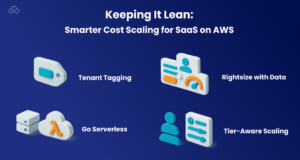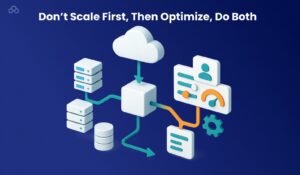Introduction
SaaS growth is good, until it becomes a problem. It usually starts with celebration. A few hundred customers. New features flying out the door. Then the AWS bill hits. Suddenly, you’re wondering why you’re paying for compute resources your users aren’t even touching. That’s the double-edged part of SaaS on AWS. It’s flexible, scalable, and fast to build with. But when usage scales across hundreds (or thousands) of tenants, complexity creeps in. Slowly. Quietly. Expensively. Your architecture has to stay elastic, resilient, and isolated where it counts, all without blowing your infrastructure budget. And if you didn’t plan for that from day one? You’re probably dealing with performance tradeoffs, visibility gaps, or worst of all: confused support tickets from high-paying customers.
This guide breaks down what actually works when scaling SaaS on AWS, not in theory, but in real-world environments. We’ll go over architecture models, AWS SaaS architecture choices that don’t implode at scale, what teams get wrong, and where AWS consulting services can keep you from hitting a wall.
Why SaaS Scaling Needs a Different AWS Strategy
Scaling a SaaS app isn’t just about handling more traffic. It’s about handling more people, using the same app in very different ways. With SaaS on AWS, you’re not just scaling a backend, you’re scaling a business model, data boundaries, performance guarantees, and shared infrastructure, all at once.
Here’s what complicates it:
- Some tenants barely use the product. Others hammer it 24/7.
- Some care about speed. Others care about compliance.
- And everyone, somehow, expects perfect uptime.
You need to support multi-tenancy, elastic infrastructure, secure data separation, tenant-level usage tracking, the works. AWS SaaS architecture gives you tools for that, but only if you architect for that.
You’ll likely need a stack that mixes:
- Stateless compute (Lambda, ECS, etc.)
- Tenant-aware databases (like Aurora or DynamoDB with partitioned keys)
- Shared storage like S3 with scoped access
- And something to meter, tag, and track usage per tenant
Just slapping things together like a regular web app won’t cut it. We’ve seen teams try. Most fail quietly, until something explodes during a product launch.
Want scalable AWS cloud scalability? Design for it. Don’t patch it in later.
Architecture Patterns That Work (and Why)
Let’s get into the patterns. What real SaaS teams build on AWS when they’re planning to scale.
There are basically three camps. Each has tradeoffs.
Silo Model – Full Isolation
Every tenant gets their own stack: dedicated VPC, DB, even compute if needed.
Why it’s great:
- Maximum data separation
- Great for compliance-heavy industries
Why it’s painful:
- It’s pricey
- Managing 100+ silos becomes chaotic fast
Best for: Healthcare, finance, or anything where “your data must never touch theirs” is non-negotiable.
Pooled Model – Everyone Shares, Carefully
One shared backend, all tenants use the same services. You separate concerns at the data layer.
Why it’s great:
- Efficient scaling
- Simple to maintain (initially)
Why it’s tricky:
- Data partitioning gets complex
- Noisy neighbors can slow others down
Best for: Low-sensitivity SaaS (CRMs, analytics dashboards), where performance can be flexibly managed.
Bridge/Hybrid Model – Shared Core, Isolated Edges
This one’s a mix. Most tenants share services, but big clients get dedicated DBs, queues, or even compute.
Why it’s great:
- More control for key accounts
- Keeps cost lower for smaller tenants
Why it’s, a lot:
- You’re managing two models at once
- Automation is a must
Best for: B2B SaaS with tiered plans. It scales both free plans and enterprise clients without a total rewrite.
Most teams building SaaS on AWS start pooled, layer on isolation for top-tier customers, and transition toward hybrid once scale hits. The key? Don’t hard-code assumptions. Build AWS SaaS architecture that can flex when usage spikes, or your customer mix changes.
Keeping It Lean: Smarter Cost Scaling for SaaS on AWS

Scaling isn’t just a performance game, it’s a budgeting one too.
If your SaaS on AWS grows but your cost-per-tenant grows faster? That’s not scale, it’s burn.
So how do you stay lean while growing?
Here’s what we’ve seen work across dozens of SaaS teams:
- Tenant tagging at the infra level
Add per-tenant tags to everything. Compute, storage, bandwidth. It’s the foundation of usage-based billing, cost modeling, and resource accountability. Can’t optimize what you can’t see.
- Rightsize with data, not guesses
AWS Compute Optimizer, CloudWatch, and tools like Datadog show where you’re overprovisioned. Most teams assume they need more power than they do, and end up paying for headroom that never gets used.
- Go serverless where it makes sense
Lambda, Fargate, S3, DynamoDB, all of these scale with usage and reduce idle costs. If you’re running small services that sit around most of the day, it’s worth reevaluating.
- Use tier-aware scaling logic
Don’t treat all tenants the same. Some need real-time compute, others don’t. If your AWS SaaS architecture doesn’t support variable scaling across plans, you’re leaving money on the table.
If you’re unsure where to start? That’s where cloud cost optimization services or an experienced AWS consulting services team can help. They spot the waste you’re too close to see, and help you fix it before it becomes your burn rate.
Case Study: How a Mid-Sized SaaS Startup Cut 42% Off Its Bill
Let’s say you’re building a SaaS HR platform. You’ve got a decent user base, predictable traffic, and things seem stable, until the CFO starts asking questions about the AWS bill.
Here’s what was happening:
-
All dev/test environments ran 24/7 (but were only used 9–5).
-
Every tenant, including trial users, had a full compute slice.
-
Databases were overprovisioned, with no real usage metrics.
Their setup followed pooled architecture, but with no real controls in place.
What changed:
-
Tagged every resource by environment, region, and tenant.
-
Introduced idle auto-suspension logic for inactive tenants.
-
Split off large enterprise clients to their own isolated DBs (hybrid model).
-
Moved most internal services from EC2 to Fargate + SQS queues.
After working with an AWS consulting services team for 3 weeks, they cut cloud spend by 42%, without rewriting a single feature. Just better visibility, architecture hygiene, and usage-aware logic.
When to Bring In AWS Consulting Services
There’s a point where it just makes sense to get help.
If you’re:
-
Scaling faster than you can track usage
-
Unsure how to refactor from monolith to multi-tenant
-
Bleeding cash on infra you don’t understand
-
Or still doing manual cost allocation across shared resources…
That’s when external AWS consulting services pay off. Fast.
You’ll get:
-
Architecture reviews with cost in mind
-
CI/CD guidance for tenant-aware deployments
-
Performance audits across shared services
-
Integration with cloud cost optimization services and FinOps tooling
And probably some relief from the creeping feeling that you’re building a Ferrari but paying for a fleet of Lamborghinis.
Don’t Scale First, Then Optimize, Do Both

The biggest mistake? Scaling now and “fixing it later.”
By then, the tech debt is everywhere. Performance is inconsistent. Billing is fuzzy. And your team is drowning in dashboards and alerts that don’t tie back to tenant impact.
SaaS on AWS works brilliantly when built with intention. That means thinking about AWS cloud scalability, performance boundaries, and cost logic as one design problem, not separate ones.
Get your AWS SaaS architecture right early. Revisit it often. And when in doubt, overcommunicate with your team (or an AWS partner) about what’s actually scaling, and what’s just spending.
Technical FAQs
Q1: What’s the best AWS database for multi-tenant SaaS?
It depends. DynamoDB for pooled tenants with predictable schema. Aurora Serverless or PostgreSQL for hybrid or isolated tenants. Choose based on access patterns and tenant separation needs.
Q2: How do I track per-tenant costs in AWS?
Tag every resource with TenantID, use AWS Cost Explorer with tag-based filters, and export detailed billing reports. Tools like CloudZero, Harness, or native cloud cost optimization services can help map usage to spend.
Q3: Can Lambda support real SaaS workloads?
Yes, for bursty or low-latency services. Combine with queues and caching layers. But for heavy compute or sustained usage, use Fargate or ECS instead.
Q4: When should I move from pooled to hybrid architecture?
When performance for top-tier customers suffers, or when per-tenant SLAs require stronger isolation. AWS consulting services can model this based on current usage trends and growth projections.
Do you like to read more educational content? Read our blogs at Cloudastra Technologies or contact us for business enquiry at Cloudastra Contact Us.